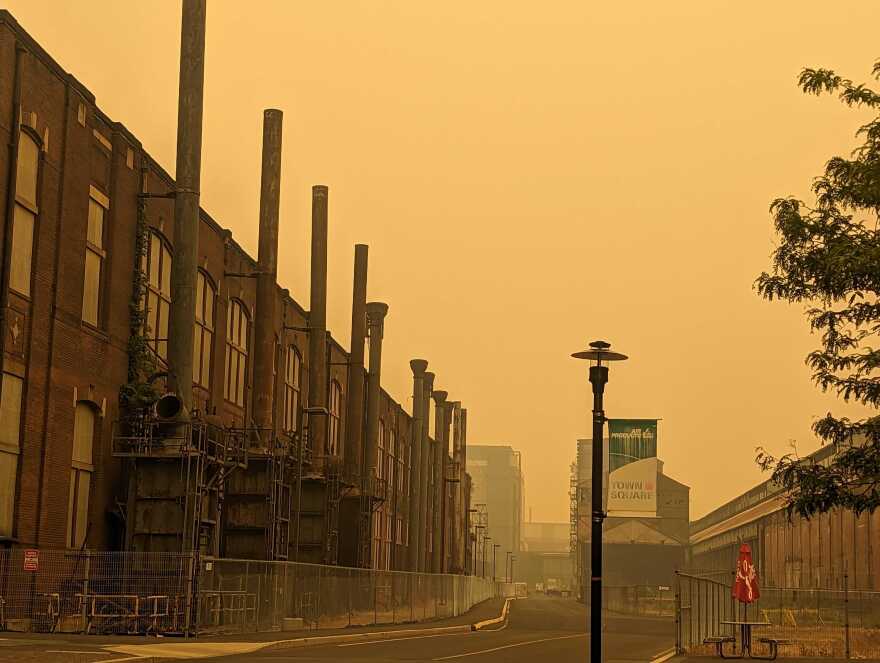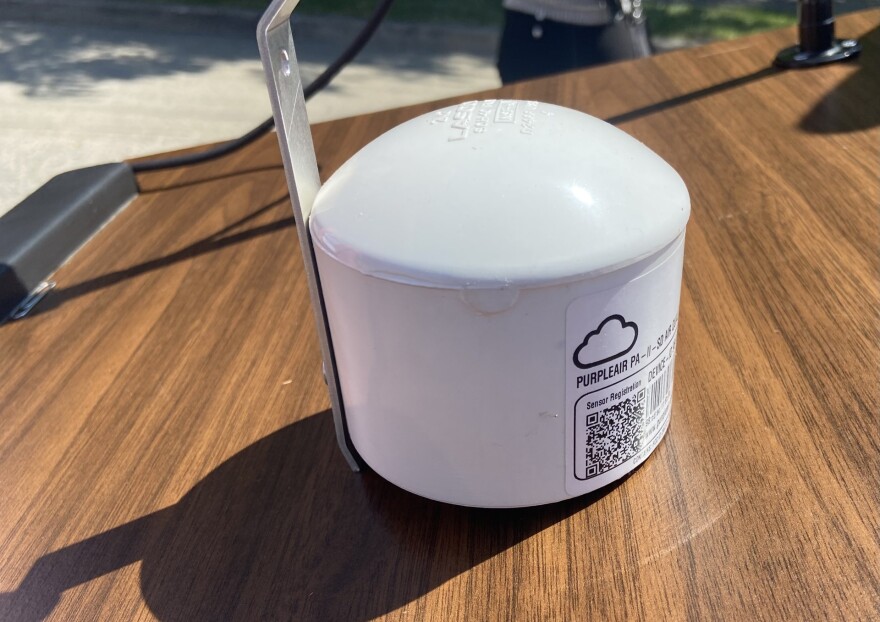BETHLEHEM, Pa. — It’s taken longer than expected to get air monitors up and running around the Lehigh Valley, Breena Holland said Monday.
“They're almost all out,” said Holland, an associate professor of political science at Lehigh University, during a phone interview.
“But, we also put together a study design so we have somewhat specific areas where the monitors need to go … Finding places to put all of them at the right distance from [major roadways with high truck traffic] has just taken a bit of time.”
Calibrating the monitors has also eaten up time, she continued, with “hiccups along the way” in the form of monitor malfunctions that required more time for repairs.
“There’s this kind of constant upkeep. So, it's been taking a little bit longer than originally expected,” she said. “And we also, now that we have almost all of them up, want to be working with a full year of data when we do our analysis.
“We are going to be waiting until we have basically all 40 monitors giving us a year of data and then doing the analysis.”
A year into it, Lehigh Valley Breathes is behind schedule.
Announced last August, the $100,000 project aims to monitor air quality amid emissions from the region’s prolific trucking and warehousing industry. As part of the effort, 40 PurpleAir monitors were slated to be installed – 20 for each Lehigh and Northampton counties; so far, 33 are installed, with plans for another four. Residents can view readings on the ShinyApp, the project’s dashboard.
While billed as a year-long project during a news conference when it launched, officials said more time is needed — it could be a year and a half more until an analysis is ready — but it won’t cost any more money.
“We've collected a lot of data, and we have, I think, some pretty strong preliminary indications about what's going on out there. But, this is a scientific endeavor, and we're not going to rush it for political purposes — essentially to meet a date that we never really thought we would be able to meet in the first place."Northampton County Executive Lamont G. McClure
“We've collected a lot of data, and we have, I think, some pretty strong preliminary indications about what's going on out there,” said Northampton County Executive Lamont G. McClure. “But, this is a scientific endeavor, and we're not going to rush it for political purposes — essentially to meet a date that we never really thought we would be able to meet in the first place.
“But we're very pleased about how this is progressing, and we think at the end of this we will have data that could potentially be actionable.”
‘What we're breathing’
Air quality has been a point of contention across the region for several years because of the booming warehousing industry contributing to heavier truck traffic and increased emissions.
The focus of Lehigh Valley Breathes is to detect and measure concentrations of PM 2.5 amid that increased truck traffic and emissions. PM 2.5 are particles so small that they’re invisible to the naked eye, but made up of a mix of chemicals that can get deep into the lungs and can cause health problems.
“Because of warehouse proliferation, we've also had the proliferation of diesel trucks on our roads, and we just really need to know what the evidence is with respect to what's in the air and what we're breathing,” McClure said.
Transportation and mobile sources are the second-largest contributors to greenhouse gas emissions, making up 27% of the Valley’s total emissions, according to a March 2023 study from the Lehigh Valley Planning Commission.
Because of this, the region already has a poor base air quality — the American Lung Association most recently graded Lehigh and Northampton counties at a “B” and “C” for particle pollution, respectively — and climate change is making it worse.
Valley residents were inundated with high concentrations of PM 2.5 for a handful of days last year, when smoke from Canadian wildfires gave the region some of the worst air quality in the nation. At the time, the air quality in Allentown, Bethlehem and Easton was so bad that breathing outdoors was the equivalent of smoking more than 14 cigarettes.

Before Lehigh Valley Breathes launched, there were already two monitors from the state Department of Environmental Protection. Those two sites, in Freemansburg and East Allentown, are monitored to ensure compliance with the federal Clean Air Act.
However, because there are only two, the data provided by those monitors don’t create a regional look at air quality. The monitoring project, officials argue, will give leaders data to improve the air and combat further issues.
So far, the project has yielded preliminary findings in line with what officials have speculated — that air quality varies by location, with higher concentrations of PM 2.5 recorded in high-traffic areas. And, fine particle pollution in the Valley is highest near warehouses and highways.
Researchers have also found PM 2.5 pollution occurs when the wind speeds are low, and conversely, when wind speeds are high, PM 2.5 pollution levels are low.
About 90 residents volunteered to host a monitor, said Andrea Wittchen of iSpring, a sustainability consulting agency. However, only some met the criteria for the study, being in close proximity to highways, warehouses or industrial sites.
“I think that the initial readings that we've gotten have indicated that we're headed in the right direction, and we're looking at the correct data to get to the answer that we want to come up with."Andrea Wittchen of iSpring, a sustainability consulting agency
“I think that the initial readings that we've gotten have indicated that we're headed in the right direction, and we're looking at the correct data to get to the answer that we want to come up with,” Wittchen said. “That was really the biggest hope, was in these early analyses that we've been able to do, to say, ‘Oh yes, this is what we theorized would be the case, and this data is actually proving that this is the case.’
“If we had found something different, if we had discovered that there didn't seem to be any correlation between traffic and PM 2.5, then we would have had to step back and say, ‘Maybe we are not on the right track here.’ But the initial stuff that we've gotten is clearly in line with what our theory is of the case.”
However, when it comes to air pollution, PM 2.5 is just one of several threats to Valley residents.
Last year, two Northampton County industrial facilities were included on a ranking of Pennsylvania’s top climate polluters. One of those facilities, Keystone Cement, recently reapplied for a hazardous waste permit from the state Department of Environmental Protection, seeking permission to bring in hazardous waste via railcar in lieu of hauling bulk shipments in tanker trucks via roads and highways.
Allentown last year was named the asthma capital of the U.S. by the Asthma and Allergy Foundation of America, climbing from third place the year prior. In March, Allentown was ranked 11th for the most challenging places to live with pollen allergies, according to the Allergy Capitals report, released by the Asthma and Allergy Foundation of America.
Since Lehigh Valley Breathes launched, at least one other air monitoring project has begun. This summer, Allentown partnered with the Center for Sustainable Innovation, or CSI, a public benefit corporation, and national nonprofit US Ignite to place air monitors outside a handful of city schools.
McClure on Monday said conversations about collaboration between the two projects are “in their infancy” with nothing concrete in place. However, he added a partnership would have the potential to help the project continue into the future.
‘Backed by evidence’
It isn’t entirely unexpected that the project is taking longer than officials originally thought, they said. Because it’s a region-wide citizen science initiative, there were some glitches to work out.
“So we're learning as we go, like most scientific experiments.”Andrea Wittchen of iSpring, a sustainability consulting agency
“If this was the kind of project that was being done at 50 different locations in the United States, and it had been going on for five or 10 years, we would have known what all these little glitches and things are that we're running into,” said Wittchen. “But it isn't — there aren't many places that are doing this, or on the scale that we're doing it.
“So we're learning as we go, like most scientific experiments.”

With the bulk of the monitors installed, or with plans to be, officials said data collection will run through August of next year, with an analysis to take place after that. That document would include recommendations for local leaders to help guide policy moving forward.
“We'll be collecting data. We'd like to do all four seasons,” Holland said. “I'm sure we'll be doing some analysis along the way, but I'm expecting to be working with the data people on the analysis most intensively in the fall of next year.”
And it’s a lot of data to sort — each monitor records the air quality every two minutes. So far, more than 6.4 million air quality readings have been collected.
It’s a “massive amount of data,” Holland said.
While reviewing the data collected, researchers can find patterns, which can, in turn, help with forecasting air quality. As time goes on and the database grows, the ability to analyze and predict air quality conditions increases.
As the project continues, both McClure and Holland said they were pleased with the progress so far.
“The goal of this project was to create a distributed air monitoring network in the Lehigh Valley that was capturing pollution and revealing the pollution levels that were near the areas where trucks are going, so people living in those areas who are really worried about that can check their own air quality, and I think it's added a lot to public awareness."Breena Holland, an associate professor of political science at Lehigh University
“The goal of this project was to create a distributed air monitoring network in the Lehigh Valley that was capturing pollution and revealing the pollution levels that were near the areas where trucks are going, so people living in those areas who are really worried about that can check their own air quality, and I think it's added a lot to public awareness,” Holland said. “ … I do think that's a significant accomplishment in itself, with respect to helping the public understand the problem.”
Moving forward, Holland is recommending any air monitors be replaced with a newer version, which also records sound levels, as there are “so many people in the Valley that are almost as upset about the noise as they are about the air pollution.”
Officials also have the opportunity to create a public platform, she added, so residents can gain a better understanding of all the different ways in which environmental pollution is impacting their health and make decisions for themselves.
“I am tremendously gratified to the entire Lehigh Valley Breathes team for bringing this idea forward to us, to help us fund it so that we can understand, on an evidence-based criteria, what public policy initiatives we may want to recommend when this thing is over,” he said. “Because so often in government, you get policy pronouncements from electeds or candidates, for that matter, that aren't backed by evidence, and when we start talking about conclusions from this project, they will at least be backed by evidence.
“And I'm really grateful for that.”


